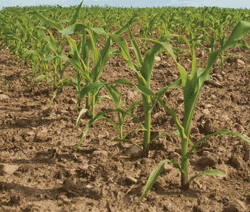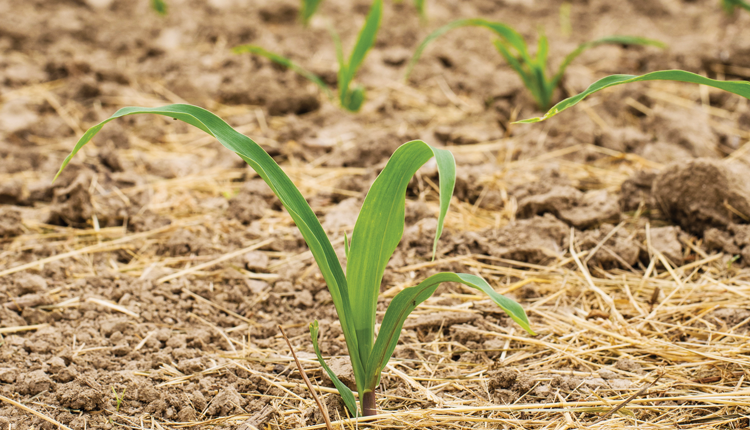Thomas is retired from the William H. Miner Agricultural Research Institute and is the president of Oak Point Agronomics, Hammond, N.Y. Mahanna is with Pioneer, a DuPont Business, and is an adjunct professor at Iowa State University.
Subsurface drainage often is called "tile drainage," but as practiced today, that's a misnomer since very few drainage installations in farm fields still are done with clay tiles. Modern drainage systems use perforated, corrugated pipe often hundreds of feet in length.
While many of the old clay tile systems were installed with backhoes, laser-guided drain plows mounted on large bulldozers are now the standard. The drain plow rips a channel in the soil approximately 3 feet deep, the depth varying with soil type and topography, and lays the pipe. This often is done in one pass, although in some tough situations (large stones, heavy clay soils), the drain plow prerips the channel and lays the pipe in a second pass.
This equipment can install thousands of feet of drain pipe per day, and the use of a laser guidance system permits the drainage of relatively flat fields. It's estimated that over 25 percent of the cropland in North America is artificially drained, a great majority of this through subsurface drainage.
It does help
 Subsurface drainage won't necessarily make a poorly-drained field into a well-drained one, but the improvement typically results in higher crop yields and especially on alfalfa and alfalfa-grass fields, better forage quality. University research in several states has shown subsurface drainage can raise corn yields by 10 to 40 bushels per acre, with similar percentage gains for other crops. A corn yield improvement of 25 bushels per acre is equivalent to 3 to 4 tons of corn silage per acre, and with a corn silage value of $60 per ton, that's about $200 per acre.
Subsurface drainage won't necessarily make a poorly-drained field into a well-drained one, but the improvement typically results in higher crop yields and especially on alfalfa and alfalfa-grass fields, better forage quality. University research in several states has shown subsurface drainage can raise corn yields by 10 to 40 bushels per acre, with similar percentage gains for other crops. A corn yield improvement of 25 bushels per acre is equivalent to 3 to 4 tons of corn silage per acre, and with a corn silage value of $60 per ton, that's about $200 per acre.
Although the per-acre cost of a subsurface drainage system varies widely, depending on pipe size and spacing, with corn silage yield differences of 3 to 4 tons per acre it doesn't take long for a subsurface drainage system to pay for itself. Before-and-after yield comparisons on several fields at Miner Institute suggest that the payback is about five years, a number also cited in some economic analyses.
Subsurface drainage permits the root systems of alfalfa and other deep-rooted crops to penetrate deeper into the soil profile, providing higher yields even during dry conditions. In fact, the best time to locate drain lines is in an alfalfa field during a dry spell because the best alfalfa growth often is right over the drain pipe.
Some subsurface drainage systems impact targeted areas, draining the wet parts of a field. However, most silty clay and clay loam soils require more extensive drainage, involving parallel or herringbone patterns that are designed to improve drainage in the entire field. A typical drainage pipe spacing on silty clay and clay loams used to be 50 feet, but in recent years the trend has been toward closer spacing.
Many drainage systems being installed today on these soil types in the northeastern U.S. are at a 30-foot spacing and are performing very well. Several years ago, a farmer in southern Quebec was harvesting his corn using a combine equipped with a yield monitor. When harvesting parallel to the drain lines in a field with 50-foot pipe spacing, he noticed that the further he got from the drain lines, the lower the yield.
Some quick calculations determined that, given the yield differences he was finding, there would be a quick payback from closer pipe spacing. He, therefore, had a drainage contractor install 4-inch drain pipe equidistant between the old drain lines, resulting in a 25-foot spacing.
A drainage system is only as good as its outlet. However, even fields with limited water outlets can be successfully subsurface drained with the installation of a pumping station as long as there's a power source near the outlet.
A pumping station essentially is a heavy-duty sump pump: The main line from the drainage system discharges water into a sump, and a pump elevates the water the several feet necessary to move it off-site. This system, inexpensive to install and operate, is in use on a 30-acre field owned by Miner Institute.
The objective of a subsurface drainage system is to remove excess water from the upper portion of the root zone within one or two days after a heavy rain. But another important benefit of these systems is to allow the farmer into the field earlier in the spring. This especially is important for dairy farmers who rely on corn silage as the backbone of their forage program.
Best decision ever
About 20 years ago, a Vermont farmer had what had been his wettest field drained at a 50-foot spacing and discovered, to his surprise and delight, that the following spring it was one of the first fields he could get on to till and plant.
When asked a few years ago if he was still pleased with the decision, he commented that it was one of the best investments he ever made.
A successful subsurface drainage system starts with a proper field survey and system layout, with installation by a qualified contractor. It needs to be planned and installed to result in a minimum volume and velocity of flow necessary to self-clean the tubing. Unless a minimum flow velocity is attained, there's a danger of silt accumulation in the tubing, thereby reducing the performance of the system. Minimum grades are established in the design, with the percentage grade depending on tubing material and soil type.
Drain tubing outlets don't require a lot of maintenance, but that doesn't mean they can be ignored. Each outlet should have a rodent guard to prevent muskrats and other rodents from crawling into and becoming lodged in the drain pipe. There's nothing that will reduce the effectiveness of a drainage system like a fat muskrat entombed in the pipe!
Subsurface drainage often is called "tile drainage," but as practiced today, that's a misnomer since very few drainage installations in farm fields still are done with clay tiles. Modern drainage systems use perforated, corrugated pipe often hundreds of feet in length.
While many of the old clay tile systems were installed with backhoes, laser-guided drain plows mounted on large bulldozers are now the standard. The drain plow rips a channel in the soil approximately 3 feet deep, the depth varying with soil type and topography, and lays the pipe. This often is done in one pass, although in some tough situations (large stones, heavy clay soils), the drain plow prerips the channel and lays the pipe in a second pass.
This equipment can install thousands of feet of drain pipe per day, and the use of a laser guidance system permits the drainage of relatively flat fields. It's estimated that over 25 percent of the cropland in North America is artificially drained, a great majority of this through subsurface drainage.
It does help
 Subsurface drainage won't necessarily make a poorly-drained field into a well-drained one, but the improvement typically results in higher crop yields and especially on alfalfa and alfalfa-grass fields, better forage quality. University research in several states has shown subsurface drainage can raise corn yields by 10 to 40 bushels per acre, with similar percentage gains for other crops. A corn yield improvement of 25 bushels per acre is equivalent to 3 to 4 tons of corn silage per acre, and with a corn silage value of $60 per ton, that's about $200 per acre.
Subsurface drainage won't necessarily make a poorly-drained field into a well-drained one, but the improvement typically results in higher crop yields and especially on alfalfa and alfalfa-grass fields, better forage quality. University research in several states has shown subsurface drainage can raise corn yields by 10 to 40 bushels per acre, with similar percentage gains for other crops. A corn yield improvement of 25 bushels per acre is equivalent to 3 to 4 tons of corn silage per acre, and with a corn silage value of $60 per ton, that's about $200 per acre. Although the per-acre cost of a subsurface drainage system varies widely, depending on pipe size and spacing, with corn silage yield differences of 3 to 4 tons per acre it doesn't take long for a subsurface drainage system to pay for itself. Before-and-after yield comparisons on several fields at Miner Institute suggest that the payback is about five years, a number also cited in some economic analyses.
Subsurface drainage permits the root systems of alfalfa and other deep-rooted crops to penetrate deeper into the soil profile, providing higher yields even during dry conditions. In fact, the best time to locate drain lines is in an alfalfa field during a dry spell because the best alfalfa growth often is right over the drain pipe.
Some subsurface drainage systems impact targeted areas, draining the wet parts of a field. However, most silty clay and clay loam soils require more extensive drainage, involving parallel or herringbone patterns that are designed to improve drainage in the entire field. A typical drainage pipe spacing on silty clay and clay loams used to be 50 feet, but in recent years the trend has been toward closer spacing.
Many drainage systems being installed today on these soil types in the northeastern U.S. are at a 30-foot spacing and are performing very well. Several years ago, a farmer in southern Quebec was harvesting his corn using a combine equipped with a yield monitor. When harvesting parallel to the drain lines in a field with 50-foot pipe spacing, he noticed that the further he got from the drain lines, the lower the yield.
Some quick calculations determined that, given the yield differences he was finding, there would be a quick payback from closer pipe spacing. He, therefore, had a drainage contractor install 4-inch drain pipe equidistant between the old drain lines, resulting in a 25-foot spacing.
A drainage system is only as good as its outlet. However, even fields with limited water outlets can be successfully subsurface drained with the installation of a pumping station as long as there's a power source near the outlet.
A pumping station essentially is a heavy-duty sump pump: The main line from the drainage system discharges water into a sump, and a pump elevates the water the several feet necessary to move it off-site. This system, inexpensive to install and operate, is in use on a 30-acre field owned by Miner Institute.
The objective of a subsurface drainage system is to remove excess water from the upper portion of the root zone within one or two days after a heavy rain. But another important benefit of these systems is to allow the farmer into the field earlier in the spring. This especially is important for dairy farmers who rely on corn silage as the backbone of their forage program.
Best decision ever
About 20 years ago, a Vermont farmer had what had been his wettest field drained at a 50-foot spacing and discovered, to his surprise and delight, that the following spring it was one of the first fields he could get on to till and plant.
When asked a few years ago if he was still pleased with the decision, he commented that it was one of the best investments he ever made.
A successful subsurface drainage system starts with a proper field survey and system layout, with installation by a qualified contractor. It needs to be planned and installed to result in a minimum volume and velocity of flow necessary to self-clean the tubing. Unless a minimum flow velocity is attained, there's a danger of silt accumulation in the tubing, thereby reducing the performance of the system. Minimum grades are established in the design, with the percentage grade depending on tubing material and soil type.
Drain tubing outlets don't require a lot of maintenance, but that doesn't mean they can be ignored. Each outlet should have a rodent guard to prevent muskrats and other rodents from crawling into and becoming lodged in the drain pipe. There's nothing that will reduce the effectiveness of a drainage system like a fat muskrat entombed in the pipe!
This article appears on page 343 of the May 10, 2012 issue of Hoard's Dairyman.











